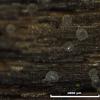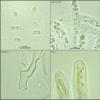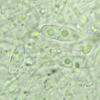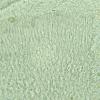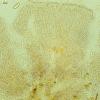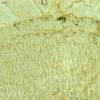
09-11-2025 13:20
Hello.A tiny ascomycete, appearing as erupting gra

08-11-2025 00:29
 Francois Guay
Francois Guay
I found this species in Quebec, Canada, on herbace

04-11-2025 09:07
Hello.A suspected Hymenoscyphus sprouting on a thi

04-11-2025 12:43
 Edvin Johannesen
Edvin Johannesen
Hi! One more found on old Populus tremula log in O

03-11-2025 21:34
 Edvin Johannesen
Edvin Johannesen
These tiny (0.4-0.5 mm diam.), whitish, short-stip
Tiny discos on Populus
Juuso Äikäs,
17-04-2021 19:34
The spores measure 9.4 - 13.1 × 3.9 - 4.2.
Any idea what might be the species/genus?
Hans-Otto Baral,
18-04-2021 16:10

Re : Tiny discos on Populus
This would require a section. Is the excipulum porrecta? gelatinized?
Perhaps a Hyaloscypha (minuta, intacta...)?
Juuso Äikäs,
19-04-2021 15:20
Re : Tiny discos on Populus
Thank you for the reply.
Unfortunately these are so small that I won't be able to make a section. But I studied the sample a bit more.
Some spores have a septum and there is a rection with the excipulum and the margin with Melzers'. I measured three asci and they were 57 - 65 × 9 - 10.5 (H2O).
H. minuta isn't found on our species list or in the monograph, but H. intacta is. It seems to fit in other parts, but there weren't even short hairs to be found. Is there a hairless version of this?
Unfortunately these are so small that I won't be able to make a section. But I studied the sample a bit more.
Some spores have a septum and there is a rection with the excipulum and the margin with Melzers'. I measured three asci and they were 57 - 65 × 9 - 10.5 (H2O).
H. minuta isn't found on our species list or in the monograph, but H. intacta is. It seems to fit in other parts, but there weren't even short hairs to be found. Is there a hairless version of this?
Hans-Otto Baral,
19-04-2021 16:15

Re : Tiny discos on Populus
H. minuta is newly combined and you find it in my Hyaloscypha folder. Yes, it is a hairless member or may have very very short hairs. It is not easy to be separated from H. intacta. Sequences exist, and as a preliminary result the two species are the same. Of course, the types are relevant in this concern. That of H. minuta I have redescribed in detail, and that of intacta Seppo has.
Strange is that the two species were described in the same year.
B.t.w., dextrinoid reactions of the ectal excipulum have variously been recorded by Huhtinen.

